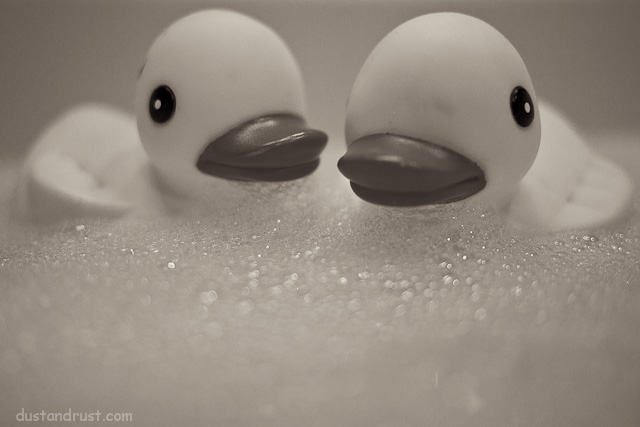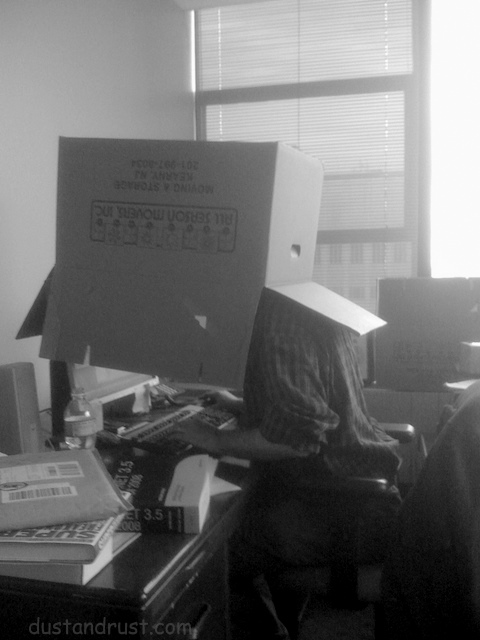I wanted to make a print to hang in my bathroom. My kids are getting older, and I always take a picture of their toys before they “move on”. These two duckies are not going anywhere yet… but I killed two birds with one stone. I used the stuff you blow bubbles with in the bathroom sink, turned off the lights and opened the blinds to get some natural light. The duckies are a little worn, but I think they have a little more character than if they were brand new.
I held my GF1 precariously in the sink just hitting the tops of the bubbles and arranged my models in various poses. I liked this arrangement the best.
Tag Archives: b&w
Thinking Inside the Box
While not as extreme as the Cardboard Office, my friend/co-worker Mike was trying to come with ideas for gaining some privacy in our temporary office space. I’ve resorted to a pair of Sennheiser EH-150’s to block out the world… but his approach does a better job of getting the point across. On the technical side, the photo was taken with my iPhone… not my first choice in photographic tools, but it’s always there when a quick snap is needed. The crappy lens adds a nice soft glow to the image.
My journey into dedicated B&W printing Part II
In my original post about setting up a dedicated B&W printer, I had already picked the printer (Epson Stylus 1400) and ink (MIS EB6). I still had a few questions about paper and setting up a workflow. I now have everything up and running, so I thought I would follow up with my results.
Q) What paper should I use?
A) Originally I was going to use Hahnemuhle Photo Rag 308. After doing some more research, I decided to stay away from papers with Optical Brightners (OBA’s). OBA’s are used in many papers to give them a very white appearance… in a manner similar to the way certain laundry detergents “brighten” your clothes. While they can add a certain punch to a photographic print, their longevity is questionable. In light of this, I decided to go with a OBA free, lignin free 100% cotton rag paper. The paper I have selected is PremierArt Smooth Fine Art Paper 325gsm. I was concerned about running a paper with this thickness through the 1400, but after a few reassuring forum replies, I went ahead and made the purchase. I’d like to give an unsolicited shout out to Atlex for their good prices and excellent service.
Q) Do I need to use Quad Tone Rip or not?
A) After experimenting with several options, I decided that Option 2 – Epson Driver – ICC in Print Preview, on page 4 of Paul Roark’s Eboni-6 guide works the best for me. Since I am getting great results from one of Paul’s profiles, the complexity of setting up Quad Tone Rip is not necessary in my case. If I was printing of a variety of papers, things might be different.
————————–
I wanted to add a few notes about the full EB6 ink / Epson 1400 / PremierArt Smooth Fine Art experience…
Cart Refills
The refill process of the MIS cartridges was straightforward, and not too messy. You can find the instructions here. The carts have a very nice “auto reset” feature where the cart resets to 100% all by itself (see the notes in the refill instructions above).
Head Clogs
The Epson 1400 sat for long periods of time (I’m talking over 4 weeks) with the EB6 ink carts installed and primed. My fears of head clogs have gone mostly unwarranted so far. I did have a minor clog in one of the colors that showed up as some missing lines in the head test pattern. It showed up after I made a 13×19 print with a lot of black coverage. For now, I will be doing a pattern check before each print.
Paper Issues
My first print on the 13×19 PremierArt Smooth had some white specks, and some odd pattern changes in the deep black areas. I had already known from my research that other users of the paper were brushing it down before using it because of this issue…. but in my excitement to make a print, I forgot to actually do it. On the second try, I used a wide camel hair paintbrush to lightly clean the paper before printing. This print came out speck/defect free. I had no issues feeding single sheets of the 325gsm 18mil paper through the Epson even though they specify the max paper thickness as 11.8 mil.
The End Result
The combination of the EB6 ink, PremierArt paper, and the Epson 1400 seem to be delivering everything I hoped they would. The OBA free paper and carbon ink gives the prints a nice warm tone. The smoothness of the ink in the deep blacks is hard to describe… and gives a very unique look on the matte paper.
My next goal is to actually offer some prints for sale. I’m trying to keep the prices very reasonable… and keeping shipping costs low (I don’t want to roll the prints in a tube). I’m looking at Print Pads from Masterpak, but they are quite heavy and expensive. If anyone has any suggestions, I’d love to hear them.

